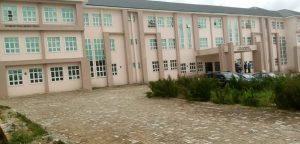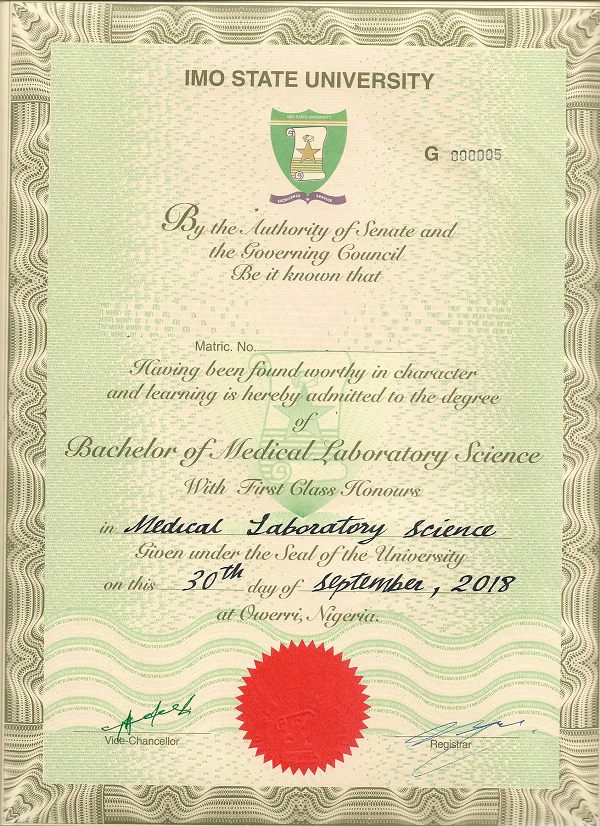Public Health
Comparative Studies On Cases Of Nosocomial Infections Acquired During Clinical Procedures In Healthcare Facilities In Abia State, Nigeria
ABSTRACT
Nosocomial infections (NIs) are infections originating in a patient while in a hospital or other health care facility. This study was carried out to compare the cases of nosocomial infections acquired by healthcare workers and patients during respiratory, urinary and gastrointestinal tract clinical procedures in healthcare facilities in Abia State, Nigeria. Medical services laborers and patients from the 3 Senatorial zones of Abia State were met with an all around organized survey. An aggregate of 422 subjects were met in this examination. Male subjects were 218 (51.66%) while female subjects were 204 (48.34%); 136 (32.23%) were from Abia Central; 128 (30.33%) were from Abia North; and 158 (37.44%) were from Abia South Senatorial zones. Out of the 422 subjects met, 74 (17.54%) were positive for nosocomial diseases while 348 (82.46%) were negative. Out of the 74 subjects that were positive for nosocomial contaminations, 28 (37.84%) were from Respiratory Tract Procedures, 26 (35.14%) were from Urinary Tract Procedures and 20 (27.02%) were from Gastrointestinal Tract Procedures. Results on the examination of clinical highlights/propensities for subjects during respiratory clinical techniques in Abia State among NI positive and NI negative subjects showed that out of the 74 subjects that were positive for nosocomial disease and among the 348 that were negative for nosocomial contamination, those that occupied with smoking were 4(5.41%) for NI positive and 56(16.09%) for NI negative; fever, 10(13.51%) for NI positive and 36(10.34%) for NI negative; sniffling, 9(12.16%) for NI positive and 64(18.39%) for NI negative; nasal blockage, 10(13.51%) for NI positive and 31(8.91%) for NI negative; hacking, 4(5.41%) for NI positive and 43(12.36%) for NI negative. Results on the correlation of clinical highlights/propensities for subjects during urinary clinical methodology in Abia State among NI positive and NI negative subjects showed that out of the 74 subjects that were positive for nosocomial contamination and among the 348 subjects that were negative for nosocomial disease in Abia State, those that had fever were 19(25.68%) for NI positive and 102(29.31%) for NI negative; uremia, 13(17.57%) for NI positive and 21(6.03%) for NI negative; diligent desire to pee, 19(25.68%) for NI positive and 25(7.18%) for NI negative. Results on the correlation of clinical highlights/propensities for subjects during gastrointestinal clinical systems in Abia State among NI positive and NI negative subjects showed that out of the 74 subjects that were positive for nosocomial contamination and among the 348 subjects that were negative for nosocomial disease in Abia State, those that had general discomfort were 24(32.43%) for NI positive and 63(18.10%) for NI negative; muscle hurt, 9(12.16%) for NI positive and 22(6.32%) for NI negative; looseness of the bowels, 11(14.86%) for NI positive and 19(5.46%) for NI negative got dried out, 15(20.27%) for NI positive and 22(6.32%) for NI negative; loss of craving, 13(17.57%) for NI positive and 25(7.18%) for NI negative. SPSS (adaptation 23) investigation utilizing the autonomous Sample T-test at 0.05 degree of importance and 95% certainty span showed a critical contrast (P<0.05) in the clinical highlights among NI positive and NI negative subjects for respiratory plot, urinary parcel and gastrointestinal lot clinical methods in all the Senatorial zones of Abia State. All in all, nosocomial diseases from respiratory plot, urinary lot and gastrointestinal parcel clinical techniques essentially affected patients and wellbeing laborers in Abia State. Medical services laborers were encouraged to consistently wear their own defensive gear for the counteraction of nosocomial diseases at work places. Ordinary hand washing and appropriate disinfection rehearses among others at wellbeing focuses were additionally suggested.
CHAPTER ONE
INTRODUCTION
1.1 BACKGROUND OF THE STUDY
A hospital-acquired infection (HAI), also known as a nosocomial infection, is an infection that is acquired in a hospital or other health care facility in a particular setting (HAI or HCAI) (HAI Data Statistic, 2018). These diseases are gotten from health facilities.
Disease is spread to the helpless patient (customer or staff) in the clinical setting by different accessible methods. Medical care staff or specialist likewise spread disease, notwithstanding sullied medical care types of gear, bed materials, or air beads
As indicated by Pollack (2010), in Europe, where medical clinic studies have been directed, the classification of gram-negative diseases are assessed to represent 66% of the 25,000 passings every year. Nosocomial contaminations can cause extreme pneumonia and diseases of the urinary plot, respiratory lot, gastrointestinal track,bloodstream and different pieces of the body. Numerous kinds of these diseases show antimicrobial opposition, which can entangle treatment.
Rules for Nosocomial Infections
Nosocomial diseases (NIs) or Hospital Acquired Infections (HAIs) are considered as those happening inside 48 hours of clinic affirmation, 3 days of release or 30 days of an activity. They influence a normal of one out of ten patients conceded to medical clinic. As per Ken, Jashree and Alison (2005) this subsequently costs the National Health Service in UK as much as a billion pounds yearly. By and large, a patient with emergency clinic gained contamination burn through 2.5-times longer in clinic, bringing about extra costs in excess of a uninfected patient. Concentrated consideration units (ICU) have the most noteworthy pervasiveness of medical clinic gained contaminations in the clinic or medical care setting (Ken, Jashree and Alison, 2005). A few factors that incline individuals to NI are depicted in Table 1.1 underneath.
Table 1.1: Factors that incline to nosocomial contamination
| S/NO | FACTORS |
| 1 | Related to underlying health status: Advanced age, Malnutrition, Alcoholism, Heavy smoking, Chronic lung disease, Diabetes |
| 2 | Related to acute disease process: Surgery, Trauma, Burns |
| 3 | Related to invasive procedures: Endotracheal or nasal intubation, Extracorporeal renal support, Surgical drains, Nasogastric tube, Tracheostomy, Urinary catheter |
| 4 | Related to treatment: Blood transfusion, Recent antimicrobial therapy, Immunosuppressive treatments, Stress-ulcer prophylaxis, Recumbent position, Parenteral nutrition, Length of stay |
Source: Inweregbu and Pittard (2005)
A nosocomial contamination is one for which there is no proof that the disease was available or brooding at the hour of emergency clinic confirmation. To be named a contamination, the condition should be showed as a clinical sickness appropriately and not a colonization, which implies that miniature life forms are address however have no unfriendly impact on the host. Notwithstanding, an asymptomatic patient perhaps thought to be tainted if pathogenic microorganisms are found in a body liquid or at a body site that is typically clean, like the cerebrospinal liquid or blood. In the event that reconnaissance information are to be utilized to precisely depict the study of disease transmission of nosocomial contaminations in the emergency clinic, the meanings of nosocomial diseases should be logically solid and applied consistently.
The most broadly utilized definitions, distributed by CDC, contain research center and clinical measures for diseases at 13 significant and 49 explicit locales (Garner, Jarvin,Emori,Horan&Hughes,1988;Oras,Gaynes,Martone,Jarvis&Emori,1992). Diseases at practically the entirety of the significant locales can be dictated by clinical measures alone, despite the fact that research center outcomes, especially microbial societies, give extra proof of the presence of a contamination. A couple of disease types frequently require positive societies, for example, asymptomatic bacteriuria and lab affirmed circulatory system contamination (Garner et al., 1988).
Nosocomial contaminations (NIs) otherwise called clinic gained diseases are diseases starting in a patient while in an emergency clinic or other medical care office. It’s anything but another confusion (random to the patient’s essential condition) related with being in the medical clinic. That is, it was absent or brooding at the hour of confirmation or the leftover of a disease gained during a past affirmation. These contaminations concern 5-15% (assessed 2 million cases yearly) of hospitalized patients and can prompt intricacy in 25-33% of those conceded in ICU (Parvez, Rekha&Rajni, 2005). Notwithstanding in general advancement, clinic obtained contaminations (HAI) establish an issue in both created and agricultural nations. These are significant reasons for death (80,000 passings every year) and monetary expenses are impressive which remember cost of extra stay for emergency clinic, drugs, postponed release and so on About 25% of the diseases can be forestalled by medical services laborers avoiding potential risk when really focusing on patients (Ohri, 2014).
Reasons for Nosocomial contaminations
Any sort of intrusive method can open the patient to the chance of contamination. Regular reasons for HAIs include:
(i) Urinary catheterization
(ii) Respiratory strategies
(iii) Surgery and wounds
(iv) Intravenous strategies
Hazard Factors of Nosocomial Infections
Other danger factors as indicated by West (2015) include:
- Long medical clinic stay
- Use of inhabiting catheters
- Failure of medical care laborers to wash hands appropriately and consistently
- Overuse of anti-microbials
- Mechanical ventilation
- Intravenous catheters
- Care of a tainted person
- Contact with tainted needles
- Preparation of a body for internment
- Sexual contact
- Contact with blood or discharges
- Serious infection
Course of Transmission
Ohiri (2014) opinioed that there are mostly three courses of transmission of nosocomial diseases specifically:
- Contact course: There are two sorts of contact courses:
Direct Contact: It requires actual contact between the irresistible individual or debased article and the helpless host.
Roundabout contact: This requires mechanical exchange of microorganisms between patients through a medical services specialist or a clinical unit.
- Air borne bead course: Droplets are particles of breath, emission that can bring microbes through the air however can just stay noticeable all around for brief timeframe.
- Air borne dust course: Dust particles will be particles that convey clean and can stay noticeable all around for extensive stretches of time.
Different Nosocomial Infections
Careful injuries: Infection of careful injuries is significant mathematically and is a reason for dreariness and delayed emergency clinic stay. In USA, occurrence investigation of careful injury represented 24% of nosocomial diseases (Hyde &Weibel, 2016). A few variables impact the event of careful injury diseases, like the site, length of medical procedure, strength of patient and ability of the administrator.
Respiratory lot diseases: These address critical extent of emergency clinic procured contaminations. Around 15-20% of all clinic obtained diseases are of the lower respiratory parcel which are the main sources of mortality. Yearning in oblivious patients and aspiratory ventilation or instrumentation may prompt nosocomial pneumonia. Gram negative bacilli and Staphylococcus aureus are the regular microbes.
Urinary plot diseases: Most of the medical clinic gained UTI (80%) is catheter related. Indeed, even the single entry of catheter is related with an unequivocal however normally low contamination hazard. Indeed, even with sufficient precautionary measures, catheterization in emergency clinics prompts UTI in about 2%; with inhabiting catheters the rate goes up to half or more (Kacmarek, Dimas and Mack, 2013). Blended contamination is normal. Diseases can be forestalled by exacting asepsis during catheterization. Inhabiting catheters are to be utilized just when unavoidable, and just with legitimate shut seepage.
Bacteremia and septicemia: Although bacteremia isn’t the most widely recognized medical clinic obtained contamination or the most critical in adding to costs, it is of most prominent significance as it’s anything but a reason for genuine disease and demise. These might be ramifications of contaminations at any site yet are generally brought about by tainted intravenous cannula. Broad investigations in USA have detailed emergency clinic procured bacteremia in 0.2-0.4% of clinic confirmations (Netter, 2014; Tortora&Anagnostakos, 2017). A lot higher rates have been accounted for tertiary consideration reference focuses than for general clinics.
1.2 STATEMENT OF THE PROBLEM
Nosocomial diseases (NIs) are critical and genuine general medical condition all through the world (Alvarado, 2000). NIs are significantly more disturbing in the 21st century because of a few reasons.These contaminations present genuine danger to clinic affirmations and the individuals who work or stay around medical clinic premises. Regardless of advances in the medical care framework, the danger to general wellbeing because of NIs actually remains. Numerous Nosocomial contaminations are brought about by microbes sent starting with one patient then onto the next, via wellbeing careworkers who don’t regularly notice basic clinic cleanliness estimates like handwashing, and furthermore between patients. Powerlessness to these contaminations has been related with utilization of obtrusive gadgets, limits old enough, safe status and disease control rehearses. Most nosocomial contaminations are believed to be communicated by the hands of medical care laborers. It is accordingly imperative to evaluate information and mentality of these medical care laborers towards NIs counteraction and control.
Emergency clinics and other medical services establishments have the essential capacity of guaranteeing that debilitated individuals recuperate from their ailments yet this isn’t generally so. Now and then, ailments get confounded and sound individuals get tainted in medical services offices. The event and undesirable outcomes of nosocomial diseases have been known for quite a few years and keep on heightening at a disturbing rate. Uncovers (2012) recognized medical services related contaminations as a significant general medical condition and stress the absence of sanitization and disinfection in clinics as a significant expanding concern, and furthermore the difficulties in non-industrial nations.
Emori and Robert (1993) did an outline of Nosocomial Infections, including the jobs of the microbiology lab, and recognized the size of the issues related with medical care procured diseases. Such issues remember the job of the microbiologist for dealing with tests by work force, and other explicit lab information. Uncovers (2012) additionally distinguished medical services related contaminations as a significant general medical issue and stress the absence of sanitization and disinfection in emergency clinics as a significant expanding concern, and furthermore the difficulties in agricultural nations.
Of need is the deficiency of examination work in the space of looking at the greatness of contaminations procured by various clinical strategies in Abia State. Comparative works done by Lanre (2012) just stressed on the mindfulness and disposition of medical services laborers in a showing clinic in Southwestern Nigeria towards nosocomial contaminations.
Studies by Oli, Okoli and Ujam (2016) in Delta State of Nigeria, and Inweregbu, Dave and Pittard (2005) just underscored the overall pervasiveness of HAI and information about the control yet didn’t manage the greatness and near investigation of the clinical strategy and the degree of association in HAIs particularly in Abia State.
This investigation was consequently centered around levels of NI obtained by medical services laborers and patients during Urinary plot, Gastro-intestinal parcel, and Respiratory lot clinical systems in some medical care foundations in Abia State specifically and Nigeria when all is said in done.
1.3 AIM AND OBJECTIVES OF STUDY
Point of the Study
The point of this investigation is to look at the instances of Nosocomial Infections (NIs) obtained by medical services laborers and patients through respiratory plot, urinary parcel and gastro-intestinal lot in medical services offices in Abia State.
The Objectives
To accomplish this point, the accompanying goals were thought of:
- To decide the instances of nosocomial contaminations gained by wellbeing laborers and patients through the respiratory plot in medical services offices of Abia State, Nigeria.
- To decide the instances of nosocomial contaminations gained by wellbeing laborers and patients through the urinary plot in medical services offices of Abia State, Nigeria.
- To decide the instances of nosocomial contaminations obtained by wellbeing laborers and patients through the gastro-intestinal parcel in medical care offices of Abia State, Nigeria.
- To analyze the general instances of respiratory plot, urinary lot and gastro-intestinal parcel Hospital Acquired Infections (HAIs) in the study area.
- To examine the health workers levels of knowledge in NI prevention/control measures and availability of equipments in the study area.
1.4 RESEARCH QUESTIONS
(i) What are the instances of nosocomial contaminations procured by wellbeing laborers and patients through respiratory plot in medical care offices of Abia State, Nigeria?
(ii) What are the instances of nosocomial diseases procured by wellbeing laborers and patients through urinary lot in medical services offices of Abia State, Nigeria?
(iii) What are the instances of nosocomial contaminations obtained by wellbeing laborers and patients through gastro-intestinal lot in medical services offices of Abia State, Nigeria?
(iv) What are the general instances of Healthcare Acquired Infections (HAIs) through respiratory, urinary and gastro-intestinal lots when analyzed in the examination region?
(v) What is the degree of information on medical care laborers on disease avoidance/control and accessibility of supplies in medical services offices of Abia State, Nigeria?
1.5 RESEARCH HYPOTHESIS
HO1: Respiratory plot clinical methods at the medical care offices of Abia State no affect the instances of nosocomial diseases.
HO2: Urinary parcel clinical techniques at the medical care offices of Abia State no affect the instances of nosocomial contaminations.
HO3: Gastrointestinal parcel clinical procedures at the medical care offices of Abia State no affect the instances of nosocomial diseases.
1.6 SIGNIFICANCE/RELEVANCE OF THE STUDY
This near investigation on instances of nosocomial diseases gained during clinical strategies in medical services places in Abia State, will be critical in the accompanying ways:
- It will help in giving proficient and logical data on the anticipation and control procedures of infectious and nosocomial irresistible sicknesses procured in our medical clinics and other medical services offices.
- It will give a knowledge on the degree nosocomial contamination counteraction methods can added to the decrease of diseases during clinical techniques in medical care offices Abia State.
- Scientific data on degree of consistence of wellbeing laborers with contamination counteraction and control would help the Government and Curriculum Planners in approach making concerning the general medical problems for the control of Urinary Tract Infection (UTI), Gastro-intestinal Disease (GID), Respiratory Tract Infection (RTI), HIV/AIDS, Syphilis, Hepatitis, Ebola Viral Disease (EVD), Covid 19 and Control of Infant and Maternal Morbidity and Mortality Rates among others.
- This study is relied upon to feature the instances of nosocomial diseases normally gained by patients and medical care laborers during clinical techniques. It’s anything but a gauge information with which Governmental and Non-legislative associations will use in making strategies and diverting financing and assets toward improving wellbeing and forestalling nosocomial contaminations during clinical methods.
- The examination will likewise instruct clinical experts who are engaged with these clinical systems the potential diseases that can emerge and subsequently, the requirements to take legitimate consideration during these strategies.
- Results and Recommendation from this examination will be valuable to researchers and specialists particularly in writing survey, referring to and further investigations on nosocomial diseases in medical care offices among others.
1.7 SCOPE, POTENTIALS AND LIMITATIONS OF STUDY
This examination on instances of nosocomial contaminations procured during clinical system was delimited to the medical services organizations in Abia State. They incorporate the essential, optional and tertiary medical care organizations and private clinics and facilities in the three senatorial zones of Abia State, to be specific Abia North, Abia South and Abia Central.
The correlation on the cases and level of nosocomial contaminations are restricted to those procured by medical care laborers and patients in the wellbeing establishments as expressed above where research information were gotten.
The Urinary Tract Infection (UTIs), Respiratory Tract Infections (RTIs) and Gastro Intestinal Tract Infections (GTIs) were the regions considered in this examination. Subsequently intrusive strategies like tasks, blood and different mixtures, and other obtrusive and non obtrusive systems were not thought of. Aside from the survey of the significant writing no exertion was made on information assortment for the etiology, pathophysiology, prescription and treatment systems of the emergency clinic obtained contaminations.
A portion of the restrictions saw by the scientist during field work were the inaccessibility of satisfactory medical clinic records. The scientist needed to depend on vis-à-vis interviews and on the site perceptions to make up the necessary information. The Covid pandemic (Covid 19) established a restriction because of the wellbeing conventions that should have been seen by the analysts, medical services laborer and patients during the field work.
The ends, proposals, counteraction and control rules produced from this investigation were restricted to the time and length of the examination.
The normal disease anticipation and control methods curious to the investigation specifically will help for legitimate wellbeing the board of contaminations coming about because of the clinic stay of patients and staff by the wellbeing supervisory crew.
The rules anticipated from the result of this exploration will consequently give a manual for the public authority in approach making and supportable administration plan of our public wellbeing programs.
1.8 AREA OF STUDY
The investigation region was different arbitrarily chosen medical services offices in Abia state, Nigeria.
Abia State
Abia state was made from a piece of Imo state in 27th August 1991. The topographical directions of Abia state is 5°25′N 7°30′E/5.417°N 7.500°E. As at the 2006 statistics, the number of inhabitants in Abia state was put at 2,833,999 (Federal Republic of Nigeria Official Gazette, 2007). Its capital city is Umuahia and the significant business city is Aba. Abia State, which possesses around 5,834 square kilometers, is limited on the north and upper east by the territories of Anambra, Enugu, and Ebonyi.
Figure 3.1: Map of Abia state (Hoiberg, 2010)
Environment of Abia State
Abia territory of Nigeria is in the warm sticky climatic zone of the heat and humidity (Odim, 2008). The normal precipitation is high and it fluctuates from 1185.0mm to 2788.00mm/hour. The stature above ocean level is 100m. The sky is regularly cloudy and significant breeze course is south west both for wet and dry seasons.
The warm damp environment lies around between longitudes 4˚N and 7˚30N in Southern Nigeria. Odim (2013) gave a portion of the Nigerians towns in this climatic zone to incorporate Aba, Port Harcourt, Lagos, Warri, Owerri, Calabar, Uyo, Benin City among others. Abia North, Abia South and Abia Central Senatorial zones were hence picked as an investigation regions for this exploration in view of their areas and spread.
Pages: 199
Category: Project
Format: Word & PDF
Chapters: 1-5
Material contains Table of Content, Abstract and References.
-

 IMSU News4 years ago
IMSU News4 years agoIs It Worth Registering a Pre-degree Program In IMSU? All you need to know about IMSU Pre-degree
-

 IMSU News5 years ago
IMSU News5 years ago7 Popular department in Imo State University (IMSU)
-

 IMSU News2 years ago
IMSU News2 years agoIMSU reprinting for 2023/2024 post UTME candidates has commenced
-

 IMSU News4 years ago
IMSU News4 years agoSteps on How to Apply for Certificate in Imo State University, Owerri (IMSU)

